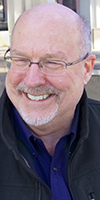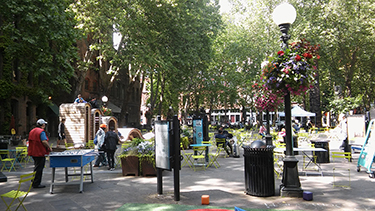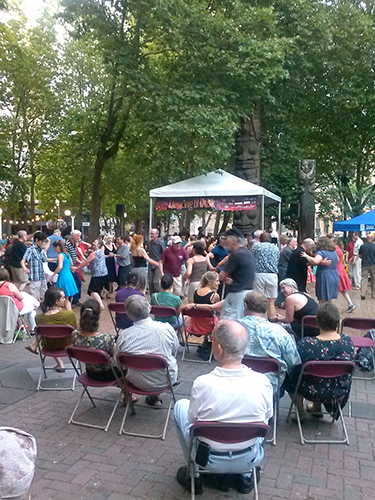|
Subscribe / Renew |
|
|
Contact Us |
|
| ► Subscribe to our Free Weekly Newsletter | |
| home | Welcome, sign in or click here to subscribe. | login |
Real Estate
| |
 |
June 23, 2016
In Pioneer Square, reality replaces myth
Walker Macy

Hinshaw
|
During most of the nearly 40 years I’ve lived in the Puget Sound a rea, I’ve been aware of the popular image of Pioneer Square.
Long before most people here were ever born, Pioneer Square bore the identity of Skid Road — a name associated with many down and out parts of North American cities. Indeed, the neighborhood is rooted in people who were down and out, rough and tumble, and marginalized by society — some criminal, some antisocial, some just strange.
Less than five blocks from where I am writing this, 115 years ago a former police chief provoked a blazing gun battle with two brothers in a drug store over a personal disagreement. The brothers walked away; the chief did not. Since then, the neighborhood has witnessed countless shootings: some lethal, most tragic.
Together with the homeless people begging for money, this image seems to be most firmly rooted in many people’s minds. Indeed, plenty of people profess that they will never set foot in Pioneer Square for fear of being hassled or seeing something disagreeable.
This image persists, despite the dramatic changes that have occurred in the last five years. Yes, homeless people are still present. Folks just have to get over that because the missions and shelters that dot the neighborhood aren’t going away. Yes, drunks still careen about late at night; although from this resident’s experience the drunks are more likely to be out-of-control Seahawks or Sounders fans than the chronically inebriated.
But despite the myth, Pioneer Square is a profoundly different place than it was just a few years ago. Now I know what you are saying. “Hasn’t this been said several times in the last 30 years, with no real change?”
Yes, there was the initial preservation period in the 1970s, with young upstart design firms, emerging artists and entrepreneurs who filled the formerly empty buildings. Eventually, the city declared it a historic district and that saved the place from demolition. The stabilizing and energizing effect was palpable. That was the era of random buskers, the running of the Ivar’s clams and Rainier beers, the occasional “streaking” office worker, and the Washington Shoe building packed with funky artists, cheek by jowl, in a glorious warren of tiny galleries. That era ran its course and the district slid gradually into a malaise.
Some years later, Occidental Park was redone and the Square seemed to be coming back again. Then the Great Recession knocked it firmly back to the point where it seemed like every other storefront was empty. For a while, all but two storefronts on Occidental were vacant.
That was truly a depressing and scary period. It was also about the time that we decided to move from the then much livelier Belltown. As Julia Roberts said in Pretty Woman, “Big mistake. Huge.” We looked around and realized that everything but a few bars closed at 5.
Enlivening the streets
But hold on. Something amazing happened. Or rather several amazing things.
Alliance for Pioneer Square was formed, which tied together a number of previously infighting factions of merchants, property owners and residents. Among the many brilliant actions by the alliance, a mechanism was set up to fund programs to enliven the streets and public spaces. Partnerships were created involving the city, service providers, waste management companies and the MID (Midtown Improvement District), a maintenance organization of the Downtown Seattle Association.
Streets and alleys were cleaned of trash, dumpsters removed, and the rat population, which fed off the former, was largely eradicated. Police presence was increased and a number of subtle but strategic moves were made to increase the sense of safety. Do people still get panhandled? You bet. But that would be true in any city in the world. If some folks don’t like that they can choose to stay in their hermetically sealed shopping centers. Frankly, at this point we don’t need them.
Multiple times a week fans of sports teams and music groups stream around the Square, filling restaurants and cafes, as well as places to drink. The place is now lively day and night; indeed many places are staying open well into evening hours even when no events are scheduled. At least 20 superb restaurants and cafes have moved in.
Five years ago The Stranger dubbed Pioneer Square the city’s sandwich capital. That may still be true but those eateries have been joined by the likes of Matt Dillon and his growing empire of splendid restaurants including London Plane and Bar Sajor. Along with the wonderful and diverse cuisines of Radici, Girin, Nirmal, Quality Athletics, Altstadt, Il Corvo, Good Bar, Taylor Shellfish Oyster Bar, Casa Antigua and others, there are splendid places to eat in every quadrant of the Square.
Some historic districts elsewhere in the country have come back mainly by being foodie meccas. That was beginning to happen here and then something else occurred. Actual shops came back. Clothing shops, shoe stores, a fabric store with classes that is open every day and evening. And many of these places are staying open later and later.
Perhaps the most significant and long-lasting impact, however, is coming from the fact that now — after decades — people want to live here. New apartments cannot be built fast enough. On virtually every parking lot there is a project underway, adding many hundreds of people, ranging from high-income to lower income. The first condominiums in 25 years are under construction, fetching top dollar.
Clearly this is not your father’s Pioneer Square. It is a compact, richly layered, dense and diverse urban neighborhood. Lately, I’ve even seen families with kids strolling about.
Finally, it goes without saying that the most astonishing new change is the soon-to-be-completed new headquarters of the Weyerhaeuser Co. This international company chose the district to relocate from its long-standing iconic building in the suburbs onto what had been one of the most forlorn blocks in the entire city. That alone belies the persistent myths about Pioneer Square. Once those 800 employees begin to explore and settle into the patterns of the district, the place will go through yet another transformational shift.
Amidst all of the changes swirling around and changing Pioneer Square back into what was Seattle’s first real neighborhood, there is one spot that has stayed pretty much the same for decades. That is the single block of Occidental between Jackson and Main.
The now fully occupied storefronts of Occidental flank a supremely elegant public space, perhaps the most refined in the city. One measure of how special this place is comes from the many wedding parties that choose it for their photos — the ultimate in romantic symbolism. Interestingly, as we have made recent attempts to convert streets into public spaces, this 80-by-240-foot rectangle remains as a stunning example of the value of simple moves: grand trees, lights and a carpet of bricks. Sometimes less is definitely more.
Mark Hinshaw is a principal with the landscape design firm of Walker Macy, which has offices in Pioneer Square. Walker Macy recently completed a study of public open spaces in the district, with recommendations for improvement. Hinshaw has lived in the neighborhood since 2009.
Other Stories:
- Going beyond the mock-up with virtual reality
- High rise vs. low rise — which is greener?
- Seattle’s building boom pushes apartment evolution
- Look to the water for affordable housing
- For older apartments, choose renovation over demolition
- Capturing the past in today’s buildings
- Is dead retail space bringing your building down?
- Ballard’s Nordic roots come out at Odin Apartments
- New lease on life for iconic First Hill apartment
- Re-energizing an old power plant site on Lake Washington




